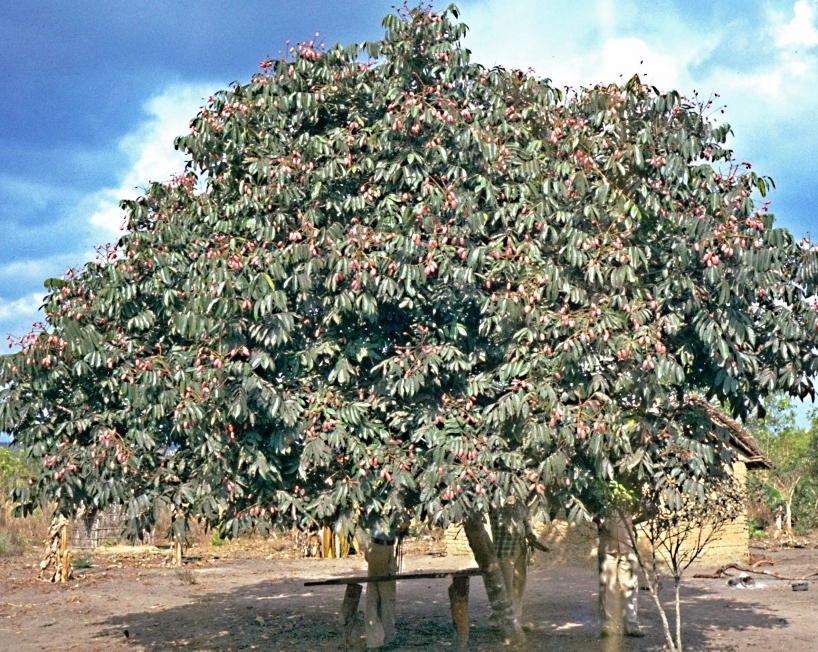Dacryodes edulis

|
|
Dacryodes edulis Common Names: Native Pear, African Plum, Bush Butter
Tree, Safou, Atanga Scientific Classification Kingdom: Plantae Clade: Tracheophytes Clade: Angiosperms Clade: Eudicots Clade: Rosids Order: Sapindales Family: Burseraceae Genus: Dacryodes Species: D. edulis Binomial Name: Dacryodes edulis (G.Don) H.J.Lam Synonyms: Canarium edule Hook.f., Canarium saphu Engl., Pachylobus edulis G.Don, Pachylobus saphu (Engl.) Engl. Morphological Description Dacryodes edulis is an evergreen, dioecious tree, growing 18–40 m tall in
forests, but typically 12–15 m in plantations. Key features include: · Trunk: Short, straight, 0.6–1.5 m diameter, with pale grey,
resin-exuding bark · Leaves: Compound, pinnate, 15–30 cm long, with 5–8 pairs of glossy,
oblong leaflets (5–10 cm long, 2–4 cm wide) · Flowers: Small, yellow, 5 mm across, in dense inflorescences; blooms
at rainy season onset · Fruit: Ellipsoidal drupe, 4–12 cm long, dark blue/violet skin, pale
green pulp, ripens 2–5 months post-flowering Two varieties exist:
var. edulis (larger fruit, stout branches) and var. parvicarpa (smaller fruit,
slender branches). Distribution and Habitat Dacryodes edulis is native to Central and West Africa, from Sierra Leone and
Nigeria eastward to Uganda, southward to Angola. It thrives in: · Regions: Humid lowland rainforests, riverine zones · Climate: Tropical, 25–35°C, rainfall 1,500–3,000 mm annually · Soil: Deep, well-drained, loamy, pH 5.0–6.5 · Elevation: Sea level to 1,000 m It adapts to varying
conditions and is cultivated pantropically, including Malaysia (Ajibesin,
2011). Ethnopharmacology Dacryodes edulis is prized in African traditional medicine, with studies
validating its uses: · Antimicrobial: Leaf extracts in Nigeria inhibit Staphylococcus aureus (MIC 62.5 µg/mL); resin disinfects wounds
(Ajibesin et al., 2008). · Anti-inflammatory: Bark is used to reduces edema; Dacryodes
edulis bark ethanolic extract has good anti-inflammatory activity. The gels
formulated using the extract retained its anti-inflammatory property comparable
to the standard gel (diclofenac gel). (Okafo
S.E, et al., 2022). · Digestive Health: Bark decoctions in DRC treat dysentery;
pulp aids digestion in rats (IC₅₀ 0.4 mg/mL) (Okwu & Nnamdi, 2008). · Fertility/Reproductive Health: Leaf infusions enhance libido; extracts
boost testosterone in roosters (0.75% dose) (Nathalie et al., 2025). · Antioxidant: Fruit in Cameroon prevents oxidative stress; polyphenols
scavenge DPPH (IC₅₀ 14 µL) (Atawodi et al., 2009). · Antimalarial: Stem bark in Congo combats malaria; quercetin derivatives
active against Plasmodium falciparum (IC₅₀ 7.8 µg/mL) (Zofou et al., 2013). Phytochemistry Medicinal effects are
linked to bioactive compounds: · Terpenoids: Antimicrobial, anti-inflammatory (Ajibesin, 2011) · Flavonoids: Quercetin, ethylgallate—antioxidant, antimalarial (Zofou et
al., 2013) · Phenolics: Gallic acid—antioxidant, digestive aid (Atawodi et al.,
2009) · Saponins/Tannins: Antibacterial, astringent (Okwu &
Nnamdi, 2008) · Fatty Acids: Oleic, linoleic—nutritional, anti-inflammatory (Ajibesin,
2011) ⚠ Toxicity Profile: No acute toxicity at culinary doses; leaf extract LD₅₀ > 5,000 mg/kg in rats. High doses may cause mild GI distress due to tannins. Avoid excessive use in pregnancy due to limited data (Ononamadu et al., 2020). Additional Uses · Culinary: Pulp (50–60% oil) boiled/roasted, used as butter or with
maize · Economic: Timber (hard, durable) for construction; fruit traded
regionally · Environmental: Agroforestry shade tree, soil stabilizer · Cultural: Resin in rituals; bark in traditional healing References
External Links More Pictures |
|
| Compounds of Dacryodes edulis | |
| References |